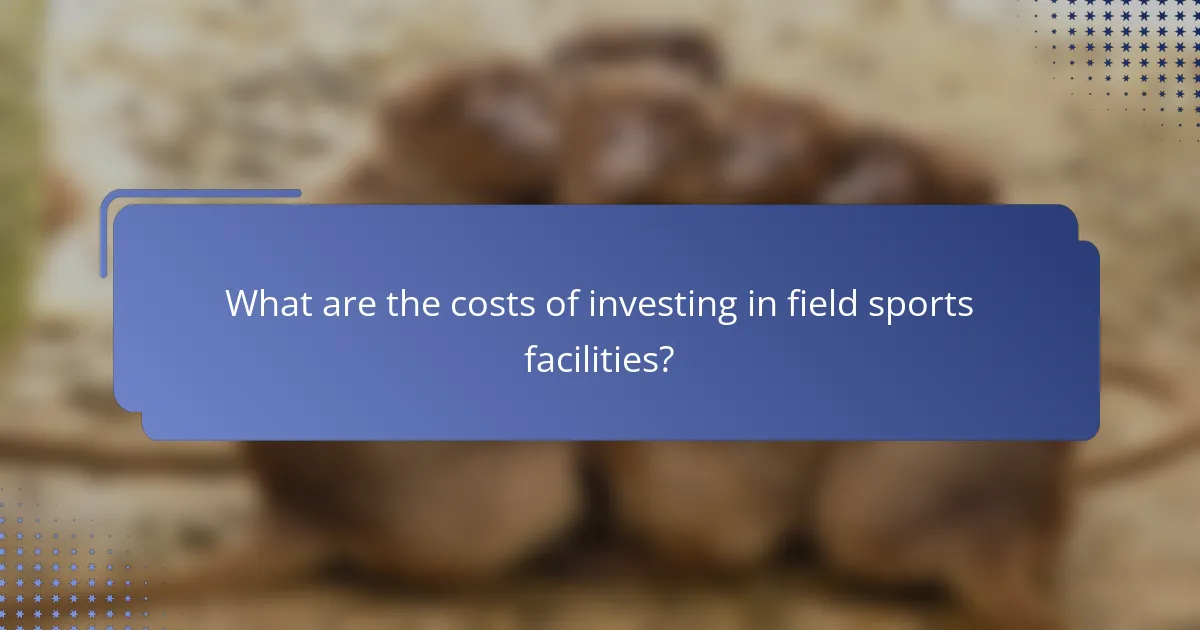Investing in field sports facilities presents a unique opportunity for communities to enhance social interaction, promote health, and stimulate local economies. While the initial costs can be significant, the long-term benefits—including job creation, increased business revenue, and improved quality of life—underscore the importance of careful cost-benefit analysis in these projects.

What are the costs of investing in field sports facilities?
Investing in field sports facilities involves various costs that can significantly impact community budgets. Understanding these expenses is crucial for making informed decisions about funding and development.
Construction expenses
Construction expenses for field sports facilities can vary widely based on location, size, and design. Basic fields may cost in the low hundreds of thousands of USD, while more complex facilities with seating and amenities can exceed several million USD. Factors such as land acquisition, materials, and labor should be carefully considered during budgeting.
It’s essential to account for local building codes and regulations, which can influence construction costs. Engaging with experienced contractors can help provide accurate estimates and avoid unexpected expenses.
Maintenance costs
Maintenance costs for field sports facilities typically include routine upkeep, repairs, and seasonal preparations. Annual maintenance can range from a few thousand to tens of thousands of USD, depending on the facility’s size and usage frequency. Regular inspections and timely repairs can prevent larger, more costly issues down the line.
Establishing a maintenance plan that includes budgeting for unexpected repairs is advisable. Communities should also consider the potential for volunteer support to help offset some of these costs.
Operational expenses
Operational expenses encompass staffing, utilities, and equipment needed to run field sports facilities. These costs can vary significantly based on the facility’s operational model, with annual expenses potentially reaching tens of thousands of USD. Hiring qualified staff for coaching, maintenance, and administration is crucial for effective operations.
Communities should explore partnerships with local organizations to share operational costs and enhance programming. This collaboration can also increase facility usage and community engagement.
Funding sources
Funding sources for field sports facilities can include public funding, private donations, sponsorships, and grants. Local governments often allocate budget funds for community projects, while private organizations may provide sponsorship opportunities to offset costs. Grants from sports associations or foundations can also be valuable resources.
Communities should actively pursue diverse funding avenues to ensure financial sustainability. Engaging stakeholders early in the process can help identify potential supporters and funding opportunities.
Cost comparison with other community projects
When comparing the costs of field sports facilities to other community projects, it’s essential to consider the long-term benefits and community impact. While initial investments may be higher than some projects, the potential for increased community health, youth engagement, and local economic growth can justify the expenses.
For example, investing in sports facilities may yield greater returns in community cohesion and youth development compared to smaller-scale projects. Conducting a cost-benefit analysis can help stakeholders make informed decisions about prioritizing investments in field sports facilities over other initiatives.

What are the benefits of field sports facilities for communities?
Field sports facilities provide numerous advantages for communities, enhancing social interaction, promoting health, and stimulating local economies. These venues serve as hubs for physical activity, community events, and youth development, creating a positive impact on residents’ quality of life.
Increased community engagement
Field sports facilities foster community engagement by bringing people together for various activities, including games, tournaments, and social events. These venues often host local leagues and clubs, encouraging participation from diverse groups and strengthening community bonds.
To maximize engagement, facilities can offer programs tailored to different age groups and interests, ensuring that everyone has the opportunity to participate. Regular events can help maintain interest and involvement, creating a vibrant community atmosphere.
Health and wellness improvements
Access to field sports facilities promotes physical activity, which is essential for maintaining health and wellness. Regular participation in sports can lead to improved cardiovascular health, increased strength, and better mental well-being.
Communities can support health initiatives by organizing fitness programs or workshops at these facilities. By providing resources and encouragement, local governments and organizations can help residents adopt healthier lifestyles.
Economic benefits through tourism
Field sports facilities can attract visitors for tournaments and events, generating economic benefits for the community. Local businesses, such as hotels, restaurants, and shops, often see increased revenue during these events, contributing to the overall economic vitality of the area.
To maximize tourism potential, communities should promote their facilities and events through targeted marketing strategies. Collaborating with local tourism boards can help raise awareness and attract larger events, further boosting economic impact.
Youth development opportunities
Field sports facilities provide essential youth development opportunities by offering structured programs that teach teamwork, discipline, and leadership skills. Participation in sports can also improve academic performance and social skills among young people.
Communities can enhance these opportunities by partnering with schools and youth organizations to create inclusive programs. Providing scholarships or financial assistance for underprivileged youth can ensure that all children have access to the benefits of sports participation.

How do field sports facilities impact local economies?
Field sports facilities significantly boost local economies by creating jobs, increasing business revenue, and attracting events. These facilities serve as hubs for community engagement and economic activity, leading to long-term benefits for the surrounding area.
Job creation
Field sports facilities generate a variety of job opportunities, ranging from construction and maintenance to management and coaching roles. The initial investment in building these facilities often leads to the creation of dozens to hundreds of jobs, depending on the facility’s size and scope.
Additionally, ongoing operations require staff for event management, concessions, and facility upkeep, further contributing to local employment. Communities can expect a steady influx of jobs that support not only the sports sector but also ancillary services like transportation and hospitality.
Increased local business revenue
Local businesses benefit from increased foot traffic and patronage when field sports facilities host events. Restaurants, hotels, and retail shops often see a surge in customers during tournaments and games, translating to higher sales and profits.
For example, a well-attended sporting event can lead to a significant uptick in dining and shopping, with some businesses reporting revenue increases of 20-30% during peak times. This economic boost can help sustain local businesses and encourage new ventures to open in the area.
Attracting events and tournaments
Field sports facilities can attract regional, national, and even international events, which brings substantial economic benefits. Hosting tournaments not only showcases the facility but also draws participants and spectators who spend money on accommodations, food, and entertainment.
Communities should consider the potential for hosting events when planning new facilities. By investing in high-quality venues that meet regulatory standards, they can position themselves as prime locations for future sporting events, enhancing their economic landscape.

What factors should be considered in a cost-benefit analysis?
A cost-benefit analysis for investing in field sports facilities should consider community needs, long-term usage projections, and environmental impacts. These factors help determine the viability and sustainability of the investment, ensuring it meets the community’s demands while being economically and ecologically responsible.
Community needs assessment
Understanding community needs is crucial for a successful sports facility investment. Engage with local stakeholders, including residents, sports organizations, and schools, to gather input on desired features and services. Surveys and public meetings can help identify specific sports or activities that are in demand.
Consider demographic factors such as age distribution and socioeconomic status, as these can influence the types of facilities that will be most beneficial. For example, a community with a high youth population may prioritize soccer fields and playgrounds, while an older demographic might prefer walking trails and fitness areas.
Long-term usage projections
Estimating long-term usage is essential for assessing the sustainability of a sports facility. Analyze historical data on similar facilities in the area to gauge potential attendance and participation rates. Factors such as population growth and changing interests in sports can impact these projections.
It’s also important to consider seasonal variations and peak usage times. For instance, outdoor fields may see increased activity during warmer months, while indoor facilities might have year-round demand. Planning for maintenance and scheduling can help maximize usage and minimize downtime.
Environmental impact considerations
Evaluating the environmental impact of a sports facility is vital for compliance and community acceptance. Assess factors such as land use, water consumption, and potential habitat disruption. Sustainable practices, like using native plants for landscaping and implementing rainwater harvesting systems, can mitigate negative effects.
Additionally, consider the facility’s carbon footprint. Incorporating energy-efficient technologies and materials can reduce long-term operational costs and enhance the facility’s appeal to environmentally conscious users. Engaging with environmental experts during the planning phase can provide valuable insights and help navigate regulations.

What are the best practices for designing field sports facilities?
Best practices for designing field sports facilities focus on functionality, accessibility, and community engagement. Prioritizing these elements ensures that the facilities meet the needs of users while promoting long-term sustainability and enjoyment.
Incorporating Community Input
Engaging the community in the design process is essential. Gathering feedback through surveys or public meetings helps identify specific needs and preferences, ensuring the facility serves its intended purpose effectively. For example, local sports clubs may have insights into the types of fields or amenities that would be most beneficial.
Ensuring Accessibility
Accessibility is a critical factor in facility design. This includes providing wheelchair access, appropriate signage, and facilities that accommodate all skill levels. Adhering to local regulations, such as the Americans with Disabilities Act (ADA) in the U.S., can guide these efforts and enhance usability for everyone.
Utilizing Sustainable Materials
Choosing sustainable materials can significantly reduce the environmental impact of field sports facilities. Options like recycled turf or eco-friendly building materials not only lower carbon footprints but can also appeal to environmentally conscious users. Additionally, incorporating features like rainwater harvesting systems can enhance sustainability.
Designing for Multi-Use
Designing facilities for multi-use can maximize their value. Fields that can accommodate various sports, such as soccer, rugby, and ultimate frisbee, increase usage rates and community engagement. This flexibility can lead to higher revenue generation through diverse programming and events.
Planning for Maintenance
Maintenance considerations should be integrated into the design phase. Selecting durable materials and creating easy access points for maintenance staff can reduce long-term costs. Regular maintenance schedules, including turf care and facility inspections, are essential to ensure the facility remains safe and functional over time.



